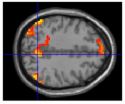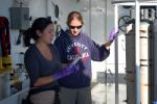(Press-News.org) VIDEO:
Extracting mitochondria from a human cell (larger object on bottom right) is a tricky process. NIST researchers recently developed techniques that can surgically remove these tiny cellular engines, potentially enabling...
Click here for more information.
Medical researchers who crave a means of exploring the genetic culprits behind a host of neuromuscular disorders may have just had their wish granted by a team working at the National Institute of Standards and Technology (NIST), where scientists have performed surgery on single cells to extract and examine their mitochondria.
The scientists reached into these cells and extracted their "engines"—the mitochondria that are in large part responsible for our metabolism. Many human cells contain hundreds of mitochondria, which were thought to be free-swimming organisms millions of years ago and which still possess their own DNA. Mutations in this mitochondrial DNA (mtDNA) are directly related to a large class of mitochondrial-based diseases, which have a range of symptoms that include early onset blindness, seizures, hearing loss, dementia, etc. In the general population, one out of every 200 people possesses a mtDNA mutation that may develop into a mitochondrial disease.
Investigating more deeply has been problematic, though, because the way mitochondria mix and spread their DNA within and among cells is poorly understood. "The trouble is that it's very difficult to extract single mitochondria from an individual cell," says NIST physicist Joseph Reiner. "For years, the best technique has been to break open a group of cells and collect the mitochondria from all of them in a kind of soup. As you might guess, it's hard to determine which mitochondria came from what cells—yet that's what we need to know."
The research team, which also includes scientists from Gettysburg College, has potentially solved this problem by realizing that several devices and techniques can be used together to extract a single mitochondrion from a cell that possesses a genetic mutation. They employed a method** previously used to extract single chromosomes from isolated rice cells where a laser pulse makes an incision in a cell's outer membrane. Another laser is used as a "tweezer" to isolate a mitochondrion, which then can be extracted by a tiny pipette whose tip is less than a micrometer wide.
This approach allowed the team to place a single mitochondrion into a small test tube, where they could explore the mitochondrion's genetic makeup by conventional means. The team found the mutation present throughout the entire cell was also found within individual mitochondria, a find suggesting that broad genetic research on mitochondrial disease may be possible at last.
"Getting an object as tiny as this from tweezer to test tube is not easy," says Koren Deckman, a biochemist from Gettysburg College. "But by building on more than a decade of work that has gone on at NIST and elsewhere, we now have a way to see the mitochondria we extract all the way through the transfer process, meaning we can be sure the sample came from a very specific cell. This could give medical scientists the inroad they need for understanding these diseases."
INFORMATION:* J.E. Reiner, R.B. Kishore, B.C. Levin, T. Albanetti, N. Boire, A. Knipe, K. Helmerson and K.H. Deckman. Detection of heteroplasmic mitochondrial DNA in single mitochondria. PLoS ONE 5(12): e14359. doi:10.1371/journal.pone.0014359.
**H. Wang, X. Liu, Y. Li, B. Han, L. Lou, K. Wang. Isolation of a single rice chromosome by optical micromanipulation. Journal of Optics A.: Pure and Applied Optics, 6, 89-93, (2004).
END
Brain scans of children with attention-deficit/hyperactivity disorder (ADHD) have shown for the first time why people affected by the condition sometimes have difficulty in concentrating. The study, by experts at The University of Nottingham, may explain why parents often say that their child can maintain concentration when they are doing something that interests them, but struggles with boring tasks.
Using a 'Whac-a-Mole' style game, researchers from the Motivation, Inhibition and Development in ADHD Study (MIDAS) group found evidence that children with ADHD require ...
Is the expansion of the universe accelerating for some unknown reason? This is one of the mysteries plaguing astrophysics, and somewhere in distant galaxies are yet-unseen supernovae that may hold the key. Now, thanks to a telescope calibrated by scientists from the National Institute of Standards and Technology (NIST), Harvard University and the University of Hawaii, astrophysicists can be more certain of one day obtaining an accurate answer.
The NIST scientists traveled to the summit of Haleakala volcano in Hawaii to fine-tune the operation of billions of light-collecting ...
As the day draws nearer for the world to run out of the unique addresses that allow us to use the Internet—now predicted to happen by the end of 2012—researchers at the National Institute of Standards and Technology (NIST) have issued a guide for managers, network engineers, transition teams and others to help them deploy the next generation Internet Protocol (IPv6) securely.
Guidelines for the Secure Deployment of IPv6 (NIST Special Publication 800-119), describes the features of IPv6 and the possible related security impacts, provides a comprehensive survey of mechanisms ...
Two new draft publications from the National Institute of Standards and Technology (NIST) provide the groundwork for a three-tiered risk-management approach that encompasses computer security risk planning from the highest levels of management to the level of individual systems. The draft documents have been released for public comment.
Both publications are a part of NIST's risk management guidelines, which have been developed in support of the Federal Information Security Management Act (FISMA), and adopted government wide to improve the security of government systems ...
In a groundbreaking achievement that could help scientists "build" new biological systems, Princeton University scientists have constructed for the first time artificial proteins that enable the growth of living cells.
The team of researchers created genetic sequences never before seen in nature, and the scientists showed that they can produce substances that sustain life in cells almost as readily as proteins produced by nature's own toolkit.
"What we have here are molecular machines that function quite well within a living organism even though they were designed ...
(PHILADELPHIA) Elevated fat and cholesterol levels found in a typical American-style diet play an important role in the growth and spread of breast cancer, say researchers at the Kimmel Cancer Center at Jefferson.
The study, published in the January issue of The American Journal of Pathology, examines the role of fat and cholesterol in breast cancer development using a mouse model. The results show that mice fed a Western diet and predisposed to develop mammary tumors, can develop larger tumors that are faster growing and metastasize more easily, compared to animals eating ...
Madison, WI December 28, 2010 – The Australian Government National Water Commission funded a study to establish an approach to assess the quality of water treated using managed aquifer recharge. Researchers at Australia's CSIRO Land and Water set out to determine if the en product would meet standard drinking water guidelines.
At the Parafield Aquifer Storage, Transfer and Recovery research project in South Australia, the team of scientists harvested storm water from an urban environment, treated it in a constructed wetland, stored it in an aquifer, and then recovered ...
Menlo Park, Calif. — The Crab Nebula, one of our best-known and most stable neighbors in the winter sky, is shocking scientists with a propensity for fireworks—gamma-ray flares set off by the most energetic particles ever traced to a specific astronomical object. The discovery, reported today by scientists working with two orbiting telescopes, is leading researchers to rethink their ideas of how cosmic particles are accelerated.
"We were dumbfounded," said Roger Blandford, who directs the Kavli Institute for Particle Astrophysics and Cosmology, jointly located at ...
An international, NOAA-led research team took a significant step forward in understanding the atmosphere's ability to cleanse itself of air pollutants and some other gases, except carbon dioxide. The issue has been controversial for many years, with some studies suggesting the self-cleaning power of the atmosphere is fragile and sensitive to environmental changes, while others suggest greater stability. And what researchers are finding is that the atmosphere's self-cleaning capacity is rather stable.
New analysis published online today in the journal Science shows that ...
(Santa Barbara, Calif.) –– Calling the results "extremely surprising," researchers from the University of California, Santa Barbara and Texas A&M University report that methane gas concentrations in the Gulf of Mexico have returned to near normal levels only months after a massive release occurred following the Deepwater Horizon oil rig explosion.
Findings from the research study, led by oceanographers John Kessler of Texas A&M and David Valentine of UCSB, were published today in Science Xpress, in advance of their publication in the journal Science. The findings show ...



